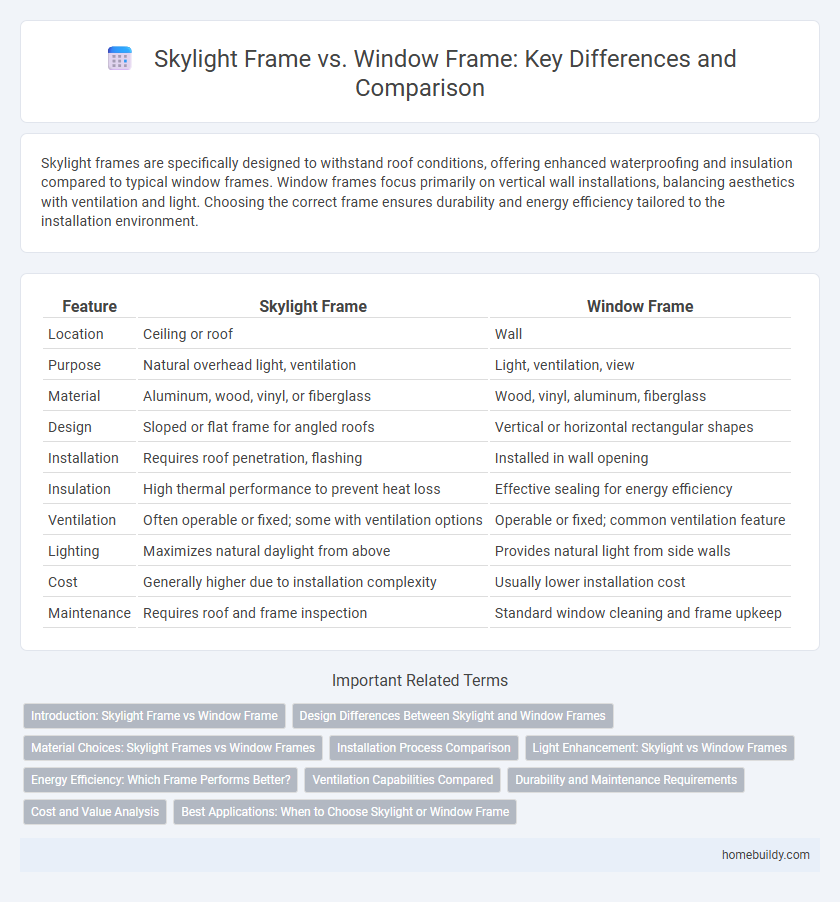Skylight frames are specifically designed to withstand roof conditions, offering enhanced waterproofing and insulation compared to typical window frames. Window frames focus primarily on vertical wall installations, balancing aesthetics with ventilation and light. Choosing the correct frame ensures durability and energy efficiency tailored to the installation environment.
Table of Comparison
| Feature | Skylight Frame | Window Frame |
|---|---|---|
| Location | Ceiling or roof | Wall |
| Purpose | Natural overhead light, ventilation | Light, ventilation, view |
| Material | Aluminum, wood, vinyl, or fiberglass | Wood, vinyl, aluminum, fiberglass |
| Design | Sloped or flat frame for angled roofs | Vertical or horizontal rectangular shapes |
| Installation | Requires roof penetration, flashing | Installed in wall opening |
| Insulation | High thermal performance to prevent heat loss | Effective sealing for energy efficiency |
| Ventilation | Often operable or fixed; some with ventilation options | Operable or fixed; common ventilation feature |
| Lighting | Maximizes natural daylight from above | Provides natural light from side walls |
| Cost | Generally higher due to installation complexity | Usually lower installation cost |
| Maintenance | Requires roof and frame inspection | Standard window cleaning and frame upkeep |
Introduction: Skylight Frame vs Window Frame
Skylight frames are designed to fit roof structures, providing natural overhead light and ventilation, while window frames are integrated into vertical walls to allow outward views and light entry. Skylight frames often require materials with enhanced weather resistance and thermal insulation to withstand rooftop exposure. Choosing between skylight and window frames depends on architectural needs, light distribution, and energy efficiency priorities.
Design Differences Between Skylight and Window Frames
Skylight frames are designed with enhanced weather resistance and low-profile aesthetics to blend seamlessly into roofs, unlike window frames which prioritize vertical visibility and structural support for walls. Skylight frames often use materials like aluminum or fiberglass for lightweight durability, while window frames commonly utilize wood or vinyl for insulation and design flexibility. The angled installation of skylight frames also requires specialized sealing and thermal breaks to prevent leaks, contrasting with the straightforward vertical placement of window frames.
Material Choices: Skylight Frames vs Window Frames
Skylight frames are commonly made from aluminum, fiberglass, or uPVC, offering strong durability and excellent weather resistance essential for overhead installations. Window frames also use similar materials but often include wood options for improved aesthetics and insulation in vertical applications. The choice of material for skylight frames prioritizes lightweight strength and UV protection, whereas window frames balance thermal performance and design flexibility.
Installation Process Comparison
Skylight frames require precise structural integration into the roof allowing natural light penetration, whereas window frames fit vertically into walls with standard masonry support. Installation of skylight frames demands careful waterproofing and flashing to prevent leaks, making the process more complex than typical window frame installations. Both frames involve securing and sealing, but skylight installation often necessitates specialized tools and expertise to accommodate roof pitch and insulation requirements.
Light Enhancement: Skylight vs Window Frames
Skylight frames maximize natural light penetration by being installed on roofs, allowing sunlight to enter from above with minimal obstructions compared to vertical window frames. Unlike traditional window frames, which are limited by wall structure and orientation, skylight frames provide enhanced illumination by capturing direct sunlight throughout the day. This architectural advantage increases ambient brightness and promotes energy efficiency in interior spaces.
Energy Efficiency: Which Frame Performs Better?
Skylight frames typically offer enhanced energy efficiency compared to traditional window frames due to their superior insulation materials and airtight sealing technology. Modern skylight frames often incorporate thermally broken aluminum or fiberglass composites that reduce heat transfer and improve overall U-value ratings. In contrast, standard window frames made from vinyl or wood may have lower insulation capabilities, impacting energy performance especially in extreme climates.
Ventilation Capabilities Compared
Skylight frames provide superior ventilation capabilities compared to traditional window frames due to their elevated positioning, which facilitates better air circulation and natural airflow. Unlike standard window frames, skylight frames often feature adjustable opening mechanisms that maximize air exchange and help regulate indoor temperature efficiently. Enhanced ventilation through skylight frames reduces humidity and improves indoor air quality, making them a preferred choice for energy-efficient and healthy living spaces.
Durability and Maintenance Requirements
Skylight frames often utilize materials like aluminum or fiberglass, offering enhanced durability against weather elements compared to traditional window frames made of wood or vinyl that may degrade faster. The maintenance requirements for skylight frames tend to be lower due to their resistance to rust, rot, and insect damage, while window frames often require regular painting or sealing to maintain integrity. Skylight frames also benefit from less frequent cleaning since they are angled, reducing debris accumulation unlike vertical window frames.
Cost and Value Analysis
Skylight frames typically cost more upfront than standard window frames due to specialized materials and installation requirements, but they add significant natural light that can reduce energy bills and increase property value. Window frames are generally more affordable and easier to replace, offering consistent durability and insulation across a wide range of styles. Investing in skylight frames yields higher long-term value through enhanced daylighting and aesthetic appeal, while window frames provide cost-effective practicality and straightforward maintenance.
Best Applications: When to Choose Skylight or Window Frame
Skylight frames are best suited for rooftop installations where natural light is a priority and wall space is limited, ideal for bathrooms, attics, and open-plan living areas. Window frames excel in vertical wall applications, providing ventilation, views, and architectural definition in bedrooms, living rooms, and offices. Choosing a skylight frame enhances daylighting and energy efficiency in low-light spaces, while window frames offer better accessibility and egress options.
Skylight frame vs window frame Infographic

 homebuildy.com
homebuildy.com